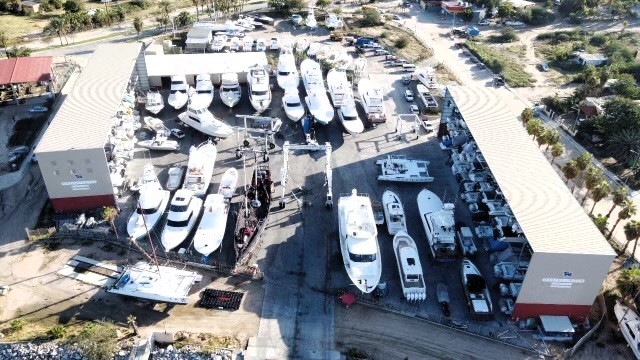
Plans for Sitka’s new marine haulout and boatyard are being tweaked, as early engineering studies are completed.
At its November meeting, the board of the Gary Paxton Industrial Park – site of the new facility – approved a few compromises to keep the project on budget, as some expenses begin to exceed estimates.
The first unexpected expense is pile driving. Just five years ago, Sitka constructed a floating dock right next door to the proposed site of the haulout, with pilings stout enough to moor a small cruise ship.
Engineers naturally assumed that the pilings for the haulout would be about the same length as those installed for the dock, but that proved not to be the case. A geotechnical study conducted earlier this year found that some of the haulout’s piles would run about 80 feet longer than anticipated.
Municipal engineer Michael Harmon reported to the GPIP board on Nov 13 that this was going to affect the original $8.1 million budget.
“So those are very significant costs,” Harmon said. “When it comes to pile driving it is a large portion of our budget. So that put us back on our heels, and we did what we try and do well, which is to improvise and overcome and figure out ways to get back within budget.”
Nevertheless, Harmon said that he and the consulting team from PND Engineering in Juneau were able to adjust the spacing of the piles, adjust the width of the planking, and reduce the size of the uplands area to make up the difference in costs.
Harmon told the board that these changes would have been efficient, even without the necessity of having to balance the budget.
“We can all have different opinions,” he said, “but if I was king for a day and owned all this, I would have made this modification from the beginning, even if you weren’t short of money, and funded some of our other alternates. So this in my mind is a really good refinement that’s going on, regardless of being short of money”
Among the plan alternates are upgrading the 150-ton boat hoist to a state-of-the-art variable hoist, which can adjust its width to park more boats in a smaller area, and turn all four wheels to travel in any direction. It would have been just over $350,000 more expensive than a conventional travelift, and wouldn’t require the support of a “yard trailer” (at a cost of $330,000) to park boats in tighter spaces.
Board member Chad Goeden wondered if it wouldn’t be smarter to keep the more expensive machine in the budget, and trim expenses elsewhere.
“We’re never going to upgrade this travelift later, so what we get this time is for our lifetimes, essentially,” Goeden said. “And that’s why I’m hesitant to scale back on this travelift when that is the number-one feature that we’re going to be using day in and day out. And if we skimp on that with the idea that ‘Well now, we’re gonna get this transporter too,’ we’re paying two people to do one person’s job forever.”
Other board members were concerned about the variable travelift’s unproven technology, and preferred to go with the known quantity of a conventional hoist. There was consensus, however, on a recommendation from park executive director Garry White to forgo a temporary washdown pad and instead spend $50,000 for a heated, concrete pad. They also approved White’s advice to spend just over $130,000 for anodes to protect the galvanized pilings from electrical corrosion.
The good kind of electricity remains high in the minds of board members who own boats, and plan to use the yard. The base bid for the project doesn’t include electrical infrastructure. Marine fabricator Jeremy Serka, speaking from the public, wanted the board to stay focused on outcomes.
“As a boat owner, I’d probably want to have some power and water, and a permanent washdown pad before I would consider a travelift that moved sideways.”
Board member Lauren Mitchell concurred. She’s brought up the issue of shore power at previous engineering and budget reviews, and she was frustrated that it was not getting attention.
“I don’t see how you can work on your boat without power,” said Mitchell. “It’s really just putting a lot of strain on people to get creative, I guess.”
The board asked city staff to look into the costs of providing shore power to boats. Municipal administrator John Leach said that Sitka currently had no electrical director, so they’d likely have to pay for outside help with electricity.
The total cash on hand for the project stands at $9.2 million: The $8.1 million withdrawal from the city permanent fund approved by voters last year, plus $1 million from a Denali Commission grant, plus a $100,000 appropriation from the city in 2021.






























